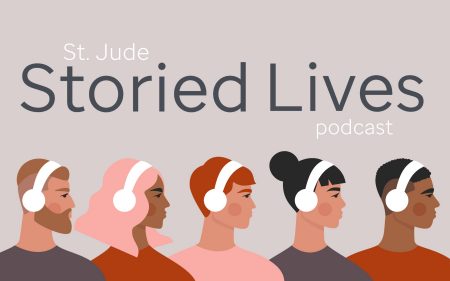
For the Love of Olivia
She’s a 3-year-old girl facing leukemia, but not alone — Mom, Dad and her twin brother are with her every step.

July 26, 2019 • 10 min
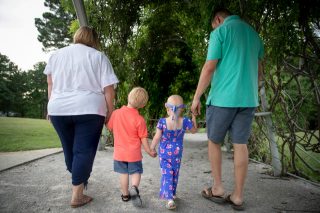
They were in the car, getting ready to leave. But first, they were doing what cancer families do — running through a checklist of medications, making sure they hadn’t forgotten one.
And from the backseat, 3-year-old Olivia says: "I didn’t take my gabapentin.”
“We didn’t even know she knew that word,” says Kacie, mom to Olivia and her twin brother Owen, and wife to Peter.
Kacie and Peter laugh. It helps to laugh, even if the reason your little girl knows the name of gabapentin, a pain medication, is because she’s being treated for acute lymphoblastic leukemia (ALL) at St. Jude Children’s Research Hospital.
This is life when your child has been diagnosed with cancer. It’s as if the whole family has been diagnosed: You’re a cancer family now, and for each family member, that new reality manifests in a unique way.
“We’re absolutely a cancer family,” Kacie says. “When I talk about ‘We have chemo,’ I don’t have chemo. But I’m there.
“We all take it on. Olivia’s carrying the brunt of that. But yeah, it’s definitely more of a we, an entire entity rather than just her.”
For patients with ALL, the most common type of childhood cancer, the survival rate at St. Jude is 94 percent. But treatment can be a two-and-a-half year ordeal of chemotherapy, medical scans, and being there for each other.
The family hurts together. The family heals together.
“Which I think is a good thing,” Kacie says, “because she’s not by herself in it.”
Olivia
She was first born, by a minute, and bigger, by a pound. And though the twins were premature, Olivia, unlike Owen, didn’t spend any time in the neonatal intensive care unit.
“So I guess in that sense she was showing her strength, in a way,” Kacie says.
And now?
“The pokes and the tests and all that, she just kind of rolls with it,” Kacie says. “If you ask her if she’s sick, she says, ‘No, I just have leukemia.’ It doesn’t stop her.”
The once-shy girl has bonded with her caregivers, and blossomed into “this little, independent person,” Kacie says. “She has been amazing.”
Peter says she’s 3 “going on 30.”
Olivia’s not just a model patient, she’s a nurse in training. Really.
“At St. Jude, they give you a port doll,” Kacie says. “And it’s just this stuffed doll that has a pretend port in it to normalize the ports that the kids get. And they give you this kit that has a line in it and some basic stuff.
“Well, Olivia has taken that to the extreme. And so we do not leave St. Jude without coming home with some medical equipment... She has decided that she wants be a line nurse already at the young age of three.”
So when Owen had his tonsils removed this summer, Olivia wanted to be there as his nurse.
And when Kacie fell and scratched her knee, Olivia applied liberal amounts of alcohol. “It stung to death,” Kacie says. “But she cleaned it all up. I didn’t get an infection.”
Emotionally strong, empathetic, intelligent — if Olivia really were 30 instead of 3, we might describe her as deep.
But in one important aspect — losing her hair during chemotherapy — Olivia’s reaction seemed more in line with her age. Kacie says Olivia losing her hair was “definitely the part I was dreading the most,” and she feared it might make her daughter “even more reclusive.” Peter shaved his head, in solidarity.
For a 3-year-old, though, perhaps hair’s just hair.
“I think, honestly, when she started losing her hair, and we shaved her head, that’s when we really saw a different kid come out,” Kacie says. “Her eyes are brighter. Her smiles are bigger.”
Mom’s theory on this transformation? “People started talking about how pretty she looks, and that went to her head — in a good way, I mean.” She laughs.
About that time, something else happened: ALSAC, the fundraising and awareness organization of St. Jude, began working with Olivia and the family on a series of videos chronicling their cancer journey.
“When they first approached us, I was like, I don’t know how this is going to go, because she’s so quiet and reserved,” Kacie says. “And we both agreed, we’ll just go with it until she doesn’t like it. And if she ever doesn’t want to do it, then we can pull it.
“But she loves it.”
Who doesn’t want to be praised? Who doesn’t warm to positive attention? But with Olivia, there seems to be more at play. She seems to identify more with adults than with other children. Give her a doll — a toy — and she turns it into a career choice.
“She interacts better at St. Jude than with kids her own age at this point," Kacie says. "Which is different. It’s not good or bad. It’s just different.
“I kind of look at myself. I was an only child growing up. So I was raised around older kids.”
Is 3-year-old Olivia wise beyond her years? An old soul in a preschooler’s body?
Peter puts it this way: “She’s an only child with a brother.”
Owen
Owen is 3, going on 90 miles per hour.
“Never met a stranger, into a lot. Very inquisitive and moving,” Kacie says. “When he gets hurt, it’s a big deal. He skins his knee, it’s a big deal. Whereas she’s just like, It’ll get better.
“We’ve kind of joked that if one of our twins had to have leukemia, God knew what He was doing picking her.”
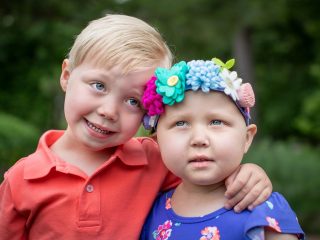
If Olivia identifies more with adults and appears older than she is (“For a 3-year-old to say methotrexate blows my mind,” Peter says), Owen finds his role models in just slightly older children — the kindergarten set. Their sense of adventure appeals.
“One of our neighbors has a kindergartener, and they were at our house. The kindergartener was sliding down our stairs on his stomach,” Kacie says. “Well, Owen slid down the stairs on his stomach. But gravity took him and he fell over top and landed back on the tile floor on the bottom.
“So he thinks he can do this stuff. That same kid was climbing a street pole, and here comes Owen, right up under him, climbing the street pole.”
Or, as mom says a few minutes later in the conversation: “He’s in a different place. He’s in daycare and learning numbers. She’s at St. Jude and learning science.”
Yet Olivia’s St. Jude experience — the family’s experience — has changed Owen, too. The boy who goes 90 miles per hour has learned to change gears and slow down. His twin sister, with whom he was inseparable before leukemia, is sick. And Owen has softened.
“When she’s hooked up to fluids overnight, or like she carried around (portable) chemo for 60 days on her nonstop — he never once tried to pull it out,” Peter says. “He doesn’t play with her the same way.”
But Even as family life revolves around Olivia these days, Kacie and Peter are mindful of letting Owen shine, too. They don’t want him to be overlooked, at such an impressionable age. They don’t want him to drift from his twin sister.
And so they carve out special time for Owen, like the day they took him trampolining with his friends. And Owen is very much a part of family life at St. Jude — even if he’s not fully aware of the seriousness of Olivia’s condition.
“When he does get sick, he thinks he needs to go to St. Jude,” Kacie says and laughs. “So I don’t think he understands quite that this is a cancer hospital.”
To Owen, St. Jude is a happy place where he can hang out with his sister. He’s made friends there. He’s spent the night. He and Olivia even had their birthday party there — the hospital’s holistic approach at work, caring for the whole family’s well-being and not just the patient’s disease.
And it was a party for both of them, in the hospital play room. They were twin-billed on the Happy Birthday banner, and the cake. They both got presents.
“So he was just as special as Olivia was that day,” Kacie says. “You would not have known, besides her not having any hair, which one was the patient.”
“Yeah, it was pretty magical for them.”
Peter
He’s the self-described “crier of the family.” He’s heart-on-the-sleeve emotional, really hates hospitals, and says, “I just don’t handle crisis well.”
So imagine how Peter took the news, in July 2018, that his then-2-year-old daughter had leukemia.
“Fear, obviously, my whole body just consumed of fear,” he says. “My first phone call was my dad in tears. And you hear the words leukemia …
“It’s definitely an emotion that consumed me entirely. And I was just dreading what could be, losing her. And you start thinking of all the negatives. You don’t process the positives just yet.”
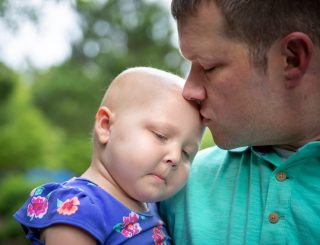
Nearly a year later, Peter has proven to be stronger than he knew. He’s embraced the positives, and even come to terms with spending hours in a hospital. Or at least, this hospital: “I don’t even think of it as a hospital anymore.”
Before he was a St. Jude dad, Peter was already a St. Jude Hero, a designation given to runners who fundraise while training for races such as the St. Jude Memphis Half Marathon.
He was running “because of the purpose, the cause,” but admittedly knew little about St. Jude.
“I was raising money for a hospital I didn’t even fully understand,” he says of running in the 2016 St. Jude Memphis Half Marathon. “But I always said, if it was my kid, I would want somebody to be doing this for them.”
Then it was his kid.
So when Peter ran again as a St. Jude Hero in 2018, just after the twins turned 3, the purpose couldn’t have been higher, and the cause had a face.
Imagine then, Peter’s emotions during the half-mile stretch where the race course winds through the campus of St. Jude, as patients and families, care givers and supporters line the sidewalks to cheer on the runners.
“We were on campus,” Kacie says. “My cousin and her kids, my dad. We made signs and were there kind of taking it all in. It was just amazing. It was crazy to see people with her Team Livi shirt on. Because you never think that’s going to be your kid. So that was crazy. … And to see people cry. And this made me cry. She even looked at me at one point and said, ‘Mommy, why are all these people crying?’"
Says Peter: “I was a mess.”
He’s running again this year, this time in the 10K. On his fundraising page is this message:
I am a St. Jude Hero! Why you ask? Well in July of 2018 I experienced what it was like to be the father of a child battling ALL leukemia. My sweet Olivia Rose was diagnosed with it and my family and I have had to learn a new normal of life.
Running is his emotional release, but Peter says, “I don’t run to get away from them.” He runs to clear his head so he can focus fully on the family and its new dynamic — so that he’s not just physically present but also emotionally. He runs to get closer to Olivia, Owen and Kacie.
He may still be the “crier of the family,” but Peter is undoubtedly more skilled at handling crisis these days. He’s living through one, but with the positive outlook — the hope — that St. Jude tells patient families is crucial to successful treatment.
“My daughter came in here with cancer. And she’s going to walk out without it,” he says. “I’m not doubting that at all.”
She’s strong. Everyone sees it, except maybe Kacie.
Kacie
“I’m a therapist — maybe I’m just doing what I have to do,” she says. “I don’t feel like that I’m doing anything differently than what anyone else would do. I don’t know. I guess I’m just kind of used to sort of” — she pauses — “managing everything.”
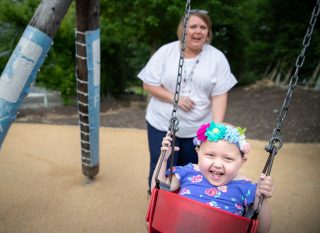
She’s the family manager. She keeps things organized and moving, even as “cancer mom” has been added to her work life as both a school social worker dealing with the emotional needs of students, and a private-practice therapist.
“I guess listening to other people’s problems, and not having to think about my own right then, is sort of a good escape for me,” she says. “And I’m a fixer, so I like to help other people. And that makes me feel good. So that’s kind of my outlet.”
And you probably saw this coming, but …
“I feel like I’m pretty good with crisis,” Kacie says.
Peter, asked to describe Kacie, says, “Stubborn — in the best possible way.”
“Oh, I agree,” Kacie says. “I would agree with that.”
Peter explains what he means:
“She doesn’t settle for no when she knows something isn’t right,” he says. “It was her initiative to get the ball rolling with the blood work and everything else” when Olivia was showing symptoms but hadn’t yet been diagnosed.
“We both may have known, but she was the assertive one. And that’s a good way to describe her. She’s very assertive, as far as getting her point across, and getting what she wants done done.”
And yet no amount of personal or professional experience can prepare a parent for hearing: Your child has cancer.
“We were going from the day before, swimming, jumping, playing normal, celebrating potty training, to where we’re a St. Jude patient,” she says.
Kacie — the strong one, remember — uses words like “absolutely terrifying” to describe the moment of hearing Olivia’s diagnosis. “All that you hear pounding in your head is leukemia, cancer, leukemia, cancer, and chemo, and things that are scary for an adult to go through,” she says. “Because everything, our normal, had just been totally rocked.”
Our normal.
That’s the reality for a family whose child has cancer. Life revolves around treatment, and the best-laid family plans — like that trip to the beach in July — are tentative, at best. There are work conflicts, the total upheaval of life at home, and the inner struggle to stay hopeful when there’s a setback in treatment.
How does Kacie keep it all together? How does Peter find the emotional fortitude? How does Owen thrive in the shadow of a very sick sister?
This cancer family, it seems, has a secret weapon. It’s Olivia, who has coped like a little champ, even as her ALL was elevated from low risk to standard risk, even through complications from medications, internal issues, neuropathy, and a recent scare that she might have sepsis.
“She doesn’t ever say, ‘When is this over?’” Kacie says. “If she ever said that, I would kind of start to have issues.”
Even as an unusually mature 3-year-old, Olivia doesn’t focus on the many months of treatment to go. She lives, as children do, in the now.
And she knows that when the treatment ends, there will be a big trip to celebrate — a big trip to make up for the one to Florida, in the summer of 2018, when she was suffering through the symptoms that would eventually send her to St. Jude.
“That’s our main thing, to give her a re-do,” Peter says. “She deserves it.”
They all do.



